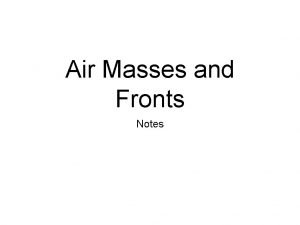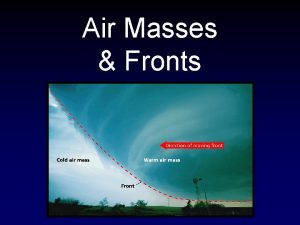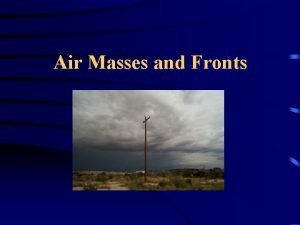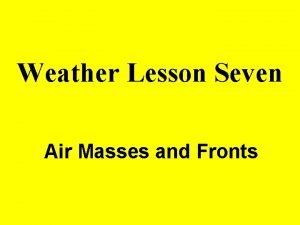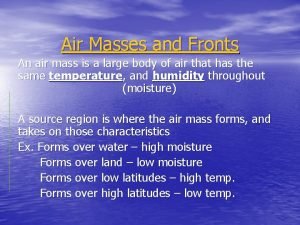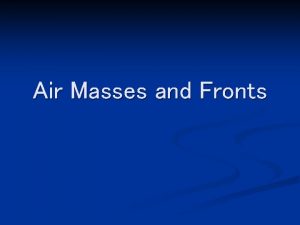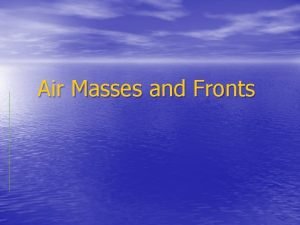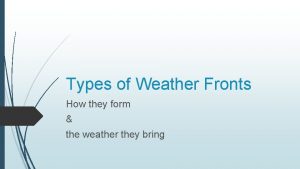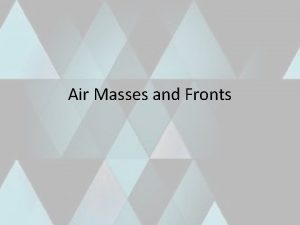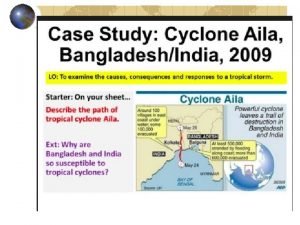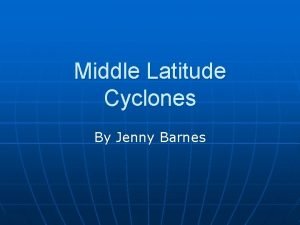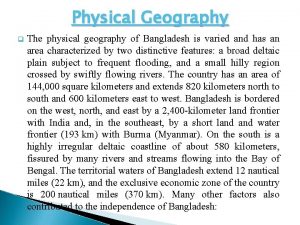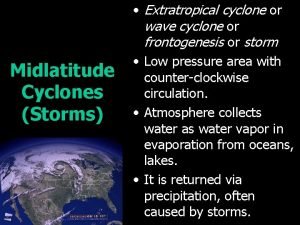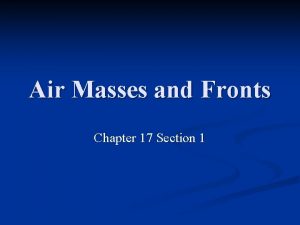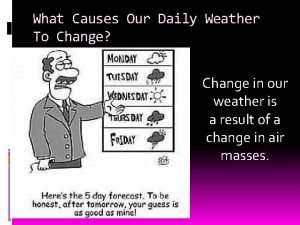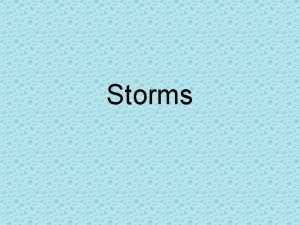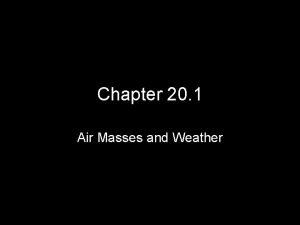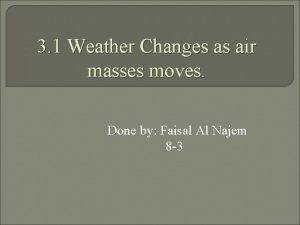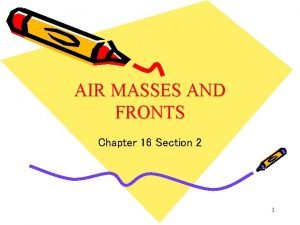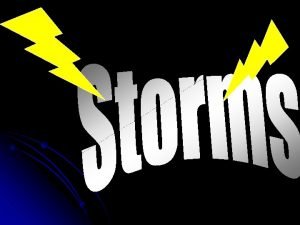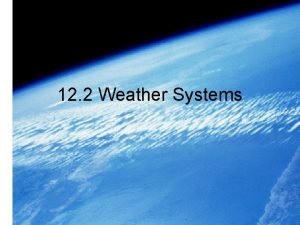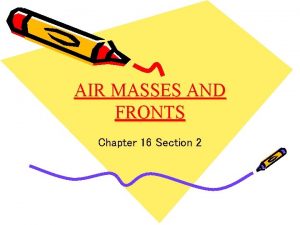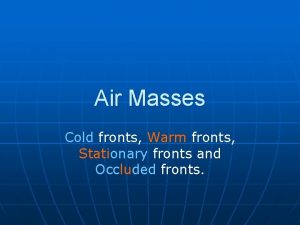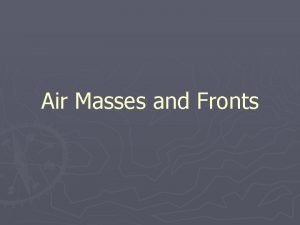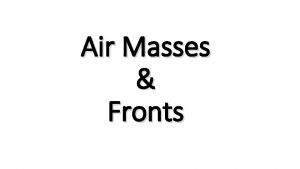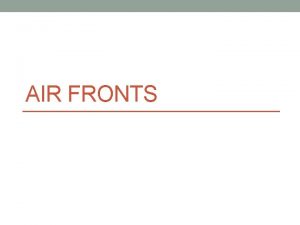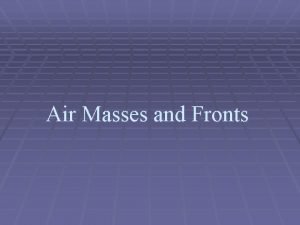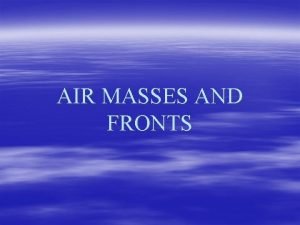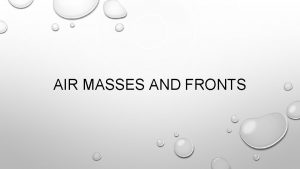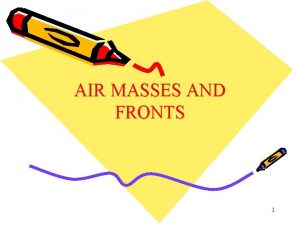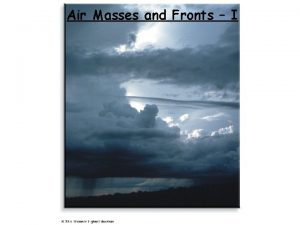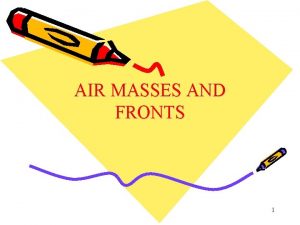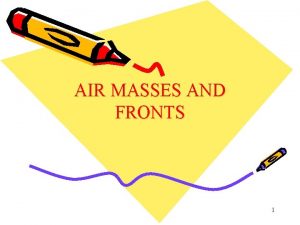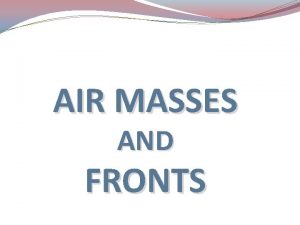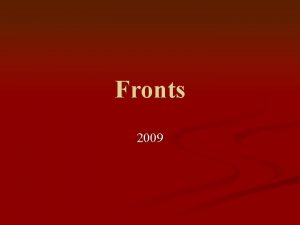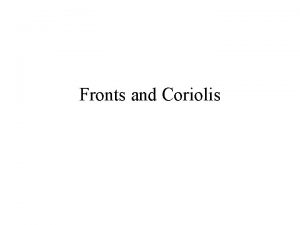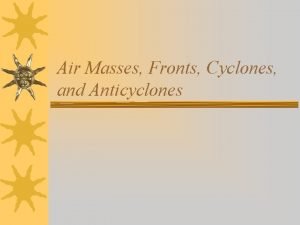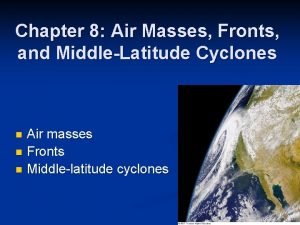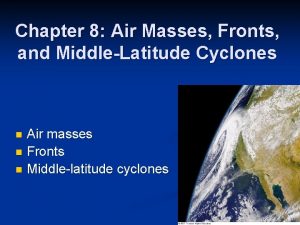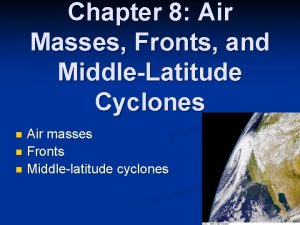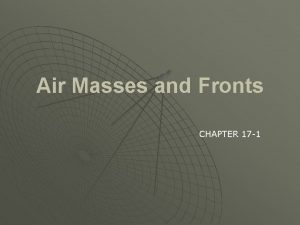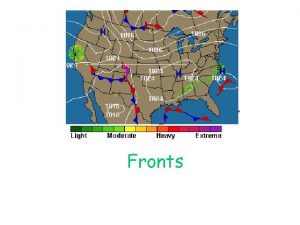Air Masses Fronts and Wave Cyclones VI Air













































- Slides: 45

Air Masses, Fronts, and Wave Cyclones

VI. Air Masses A. An Air Mass is: Immense body air, usually 1600 km 1. An _______of horizontally and several kilometers vertically. 2. Characterized by _____physical properties at uniform any given ____. altitude (In particular, temperature and moisture content. ) modify 3. Air Mass Weather: Generally, they ______ weather conditions of a region under the influence of an air mass

B. Source Regions 1. _______in The area which air masses originate and characteristics of an air determines the _________ mass.

3. Major source regions are not found in the _______latitudes. middle Subpolar latitude Subtropical latitude

C. Air Mass Classification 1. Depends on: on a. ____of Latitude the source region (determines temperature) b. The nature of the surface in the area of origin ocean or continent which determines (_________) ______conditions moisture

2. Naming Air Masses a. Air masses are named using a two-letter code. (1) First letter: lowercase (a) _______ (b) Designates _____characteristics moisture i) c for continental; ii) m for maritime (2) Second letter UPPERCASE (a) _______ (b) Designates ______conditions temperature (c) P for polar; A for arctic (colder than polar); T for tropical; E for equatorial

Air Masses in the ESRT

Examples can you guess? continental Arctic maritime Polar m. P 1 Maritime Polar c. A m. P continental Polar c. P 3 continental Tropical maritime Tropical m. T 2 c. T 4 maritime Tropical m. T

D. Modification of Air Masses (not in notes) 1. As an air mass moves it modifies _____the weather of the area over which it is moving. 2. As an air mass moves it gradually becomes modified surface over by the ______which it is moving 3. Cp moves over ocean (winter): Transforms to an unstable m. P air mass a. If colder than the surface over which it moves: lowercase k is added after the symbol for the air mass. b. If warmer than the surface over which it moves: lowercase w is added after the air mass symbol.

E. Properties of North American Air Masses Continental Polar (c. P) and Continental Arctic (c. A) 1. __________________________ a. b. c. d. e. f. Associated with winter cold waves and the first fall freeze and last spring freeze Advance between Great Lakes and Rockies No topographic barriers between high latitudes and Gulf of Mexico Therefore c. P and c. A air can easily and rapidly extend far southward into the U. S. Associated with Lake Effect Snows Often ends heat waves in summer

Lake Effect Snow • c. P air becomes moist as it crosses the Great Lakes in the winter. • It becomes unstable due to the acquired moisture and by warming from below. • The leeward side of the lakes receives the “lake effect snow. ”

Snow Belts Due to Lake Effect Snow

Lake-Effect Snow • November 9 -14, 1996 • 175 cm (~69 inches) of snow in Chardon, OH

E. Properties of North American Air Masses 2. Maritime Polar (m. P) ______________ a. b. c. d. Two important sources regions influence U. S. weather North Pacific (originate as c. P air in Siberia) Northwestern Atlantic from Newfoundland to Cape Cod (originally c. P air masses over the continent but rarely affects U. S. weather due to westerlies) Nor’easter: Winter invasion of m. P air from the Atlantic due to cyclonic winds

Winter m. P Air Masses • In winter North Pacific m. P air masses usually begin as Siberian c. P air masses. • The c. P air is modified as it slowly crosses the ocean.

E. Properties of North American Air Masses 1. Maritime Tropical (m. T) ___________ a. b. c. d. Originate over Gulf of Mexico and Caribbean Sea Often unstable (warm and moist) Winter: m. T air seldom reaches the central and eastern U. S. If it does, it becomes more stable and is associated with occasional widespread precipitation (becomes m. Tw) Summer: Associated with hot and humid conditions with frequent cumulus development and showers or thunderstorms.

E. Properties of North American Air Masses 1. Continental Tropical (c. T) _____________ a. b. c. d. North America has no extensive source region for c. T air masses. Summer: c. T air forms over northern interior Mexico and parts of the arid southwestern U. S. Unstable due to extreme temperatures but little cloud formation due to low humidity. Associated with occasional drought in the Great Plains

II. Fronts and Wave Cyclones Cyconic Winds ck ra T m Stor An enormous cyclonic storm formed in the Gulf of Mexico, moved northeastward and spawned tornadoes in FL and dumped huge amounts of snow from Alabama to Candada’s Maritime Provinces

A. Wave Cyclones 1. The primary weather producer in the________ middle latitudes (region between Florida and Alaska in the region of the westerlies). low 2. Large _______pressure systems with counterclockwise convergent West to East circulation. The systems generally move from ________. 3. Most have a cold front and often a warm front extending from central area of low the__________pressure. Also called: • low-pressure systems • extratropical cyclones • lows

The First Model Was Constructed by Norwegian Scientists During WWI • Norwegians were cut off from weather reports from the Atlantic. • They developed a closely spaced network of weather stations. • Published their model in 1921. • Their insights proved to be a turning point in meteorology. • Their model became know as: – The Polar Front Theory – Also called Norwegian Cyclone Model Vilhelm Bjerknes (Bee-YURK-ness)

B. Fronts boundary 1. Fronts are _____ surfaces separating air masses of differing densities. _____ warmer 2. One air mass is usually _____. Fronts can form between any contrasting two _________air masses Above 3. _______ground, the frontal surface slopes at a low angle allowing warmer air to overlie cooler air. 4. _______: Overrunning The general term applied to warm air gliding up along a cold air mass.

Types of Fronts Warm Fronts Cold Fronts Stationary Fronts Occluded Fronts

Front Symbols in the ESRT

a. Warm Front (1) The leading edge of an advancing _______air mass. warm collides with the cooler and receding air mass, friction (2) As the warm air ____ with the ground slows the advance of the surface position of the front. The result is a _____slope of 1: 200 (1 km height for every 200 km ahead gentle of the surface location) slow rate of advance and low slope produces light to moderate (3) The ______ precipitation over a large area, ahead of the surface position of the front. (4) Preceded by cirrostratus clouds (“halo”) and cirrocumulus (“mackerel sky’) increase (5) After the front passes temperatures gradually _____.

Clouds Ahead of a Warm Front cirrocumulus cirrostratus

b. Cold Front cold (1) The leading edge of an advancing _____air mass. slows (2) Friction with the ground ____the surface position of the front causing it to steepen as it advances. (3) Approximately twice as steep as a warm front (1: 100). faster rate (≈ 35 km/hr) than a warm front (25 ≈ km/hr). (4) Advances at a ______ (5) Forceful _____ results in cumuloform clouds with heavy precipitation lifting (often cumulonimbus with associated thunderstorms. colder temperatures. (6) Often preceded by altocumulus clouds. Followed by ____

Mid-Latitude Cyclone COOL COLD c. P m. T WARM

Today 1 -19 -11 • • Do Now: # 1 - 5 only (keep packet) Finish Notes Fronts-Cyclones (last page) Post HW answers (Review for Exam tomorrow!) Reminder…Weather Exam Review class today 10 th period, bring your review questions! • Tomorrow: Exam period 8, more practice with Topographic Maps, calc. gradient. • Friday: go over Climate Notes – El Nino • Monday: Lab Exam

c. Stationary Front Because it may remain over an area or several days, flooding is possible horizontal (1) Produced by ______air flow on either side of the front resulting in _____ no movement of the frontal boundary. (2) Overrunning occurs resulting in gentle to moderate precipitation. Wind shear (3) _______on either side of the front ultimately is responsible for the formation of a low pressure center and a wave cyclone.

d. Occluded Front (1) Produced when an rapidly advancing cold overtakes front _____ and merges a _____with warm front. new front (2) A _____forms between the advancing cold air and the air over which the warm front is sliding. (3) Complex weather that is often a combination __________ cold front & warm front __conditions results.

Types of Occluded Fronts (4) Cold-Type Occluded Front (5) Warm-type Occluded Front • Air behind the cold front is • Air behind the advancing cold front colder than the air it’s overtaking. • This the most common type east of the Rockies • Front aloft lags behind the surface position. • Weather is similar to cold front weather. is warmer than the air its overtaking • Frequently occurs along the Pacific Coast where mp air overtakes cold air that formed over the continent. • Warmer upper air arrives before the surface front (along with the precipitation).

A. The Life Cycle of a Mid-latitude Cyclone formation is called Cyclogenesis

Cyclogenesis (handout) c. P m. T

Stages in the Formation of a Middle-Latitude Cyclone

Stages in the Formation of a Middle-Latitude Cyclone The storm has used up it’s source of energy counterclockwise flow ceases to exist. Storm Intensifies with Heavy Precipitation

Summary A. The Life Cycle of a Wave Cyclone The front 1. ______Develops (Stationary)

Summary A. The Life Cycle of a Wave Cyclone A wave 2. ______Develops (Stationary)

Summary A. The Life Cycle of a Wave Cyclone 3. Cyclonic ____Circulation is established

Summary A. The Life Cycle of a Wave Cyclone Occlusion begins 4. ______

Summary A. The Life Cycle of a Wave Cyclone The occluded front is developed 5. ________

Summary A. The Life Cycle of a Wave Cyclone dissipates 6. The cyclone ______

Cloud Patterns Associated with Cyclones

Storm Tracks Movement of cyclone from March 21 -24 500 –mb chart for Mar 21 500 –mb chart for Mar 23 Upper-level air 1. _______flow has a steering effect on cyclonic movement. Directions are influenced by 500 millibar contours 2. Rate is normally 20 to 50 km/hr (_______ higher speeds occur in the winter with higher pressure gradients). northeast 3. Cyclones tend to migrate toward the ________ 4. ________are embedded between cyclones and travel Anticyclones northeastward with the cyclones.

Typical Storm Tracks

Wave Cyclone
 Air masses and fronts
Air masses and fronts Air mass chart
Air mass chart North american air masses
North american air masses Air masses in north america
Air masses in north america Two cold air masses converge on a warm air mass
Two cold air masses converge on a warm air mass Maritime polar
Maritime polar Air masses & frontswhat is an air mass?
Air masses & frontswhat is an air mass? The boundary between two adjacent air masses is called
The boundary between two adjacent air masses is called Air mass vocabulary
Air mass vocabulary Air masses & frontswhat is an air mass?
Air masses & frontswhat is an air mass? Air masses & frontswhat is an air mass?
Air masses & frontswhat is an air mass? Air masses & frontswhat is an air mass?
Air masses & frontswhat is an air mass? Types of fronts on a weather map
Types of fronts on a weather map Types of air masses
Types of air masses Describe the distribution of tropical storms
Describe the distribution of tropical storms What are middle-latitude cyclones?
What are middle-latitude cyclones? Physiography of bangladesh
Physiography of bangladesh Extratropical cyclone
Extratropical cyclone Air masses and their characteristics
Air masses and their characteristics Area of low pressure where air masses meet and rise
Area of low pressure where air masses meet and rise Air masses form in the tropics and have low pressure
Air masses form in the tropics and have low pressure Modern earth science
Modern earth science Jet stream map
Jet stream map Warm front
Warm front Large rotating air mass
Large rotating air mass Importance of air masses
Importance of air masses Characteristics of air masses
Characteristics of air masses Cyclogenesis occurs along the________.
Cyclogenesis occurs along the________. Continental arctic air mass symbol
Continental arctic air mass symbol Tropical air mass
Tropical air mass Warm hall
Warm hall Weather depression
Weather depression What are the five types of air masses?
What are the five types of air masses? What happens when 2 air masses meet
What happens when 2 air masses meet Air masses
Air masses Air masses
Air masses Narrow region separating two air masses
Narrow region separating two air masses Warm front diagram
Warm front diagram Air masses
Air masses Front
Front Difference between full wave and half wave rectifier
Difference between full wave and half wave rectifier Example of longitudinal wave
Example of longitudinal wave Piv of centre tapped rectifier
Piv of centre tapped rectifier Earthquake p wave and swave travel time
Earthquake p wave and swave travel time Electromagnetic and mechanical waves
Electromagnetic and mechanical waves Energy that travels through
Energy that travels through

